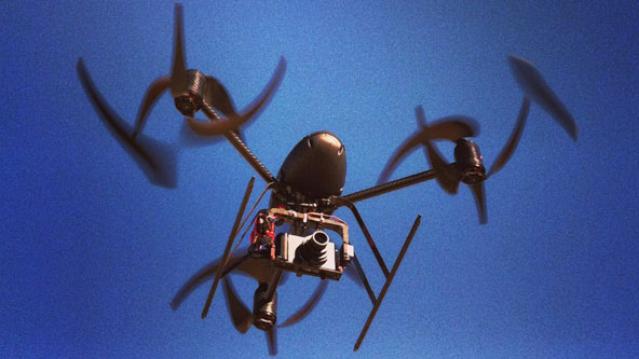North Dakota Police Can Now Legally Use Taser Drones

It’s a classic case of unintended consequences. A Republican lawmaker in North Dakota put forth legislation meant to prevent law enforcement officials from using unmanned aerial vehicles to conduct surveillance on private property without a warrant. It was transformed by fellow lawmakers into a bill allowing the police to mount Tasers, pepper spray, sound cannons and other “less-than-lethal” weapons on flying drones.
The legislation, House Bill 1328, was passed and signed into law earlier this year, but got little attention until this week, when a Daily Beast report pointed out the implications of the legislation: Law enforcement officers many miles away from suspects could have the authority to stun or otherwise incapacitate them.
Related: Ben Carson’s Idea for Controlling the Border – Military Drone Attacks
To be clear, the fact that something like this is technically legal doesn’t mean that state and local police departments will necessarily embrace the practice of remotely subduing suspects. Police officers are generally subject to local and departmental rules that can substantially limit what tactics are allowed.
The original version of the bill included language that would have barred law enforcement from mounting weapons of any kind on a drone: “A state agency may not authorize the use of, including granting a permit to use, an unmanned aircraft armed with any lethal or nonlethal weapons, including firearms, pepper spray, bean bag guns, mace, and sound-based weapons,” it said.
Supporters of the state’s police union introduced an amendment to the bill that would allow less-than-lethal weapons to be mounted on drones, according to the Daily Beast’s Justin Glawe. The amended bill was ultimately passed and signed into law.
Related: Europe Faces Up to Flight Safety Threat Posed by Drones
State Rep. Rick Becker this spring voiced his dismay at the changes to the bill in a public hearing, saying, “In my opinion there should be a nice, red line: Drones should not be weaponized. Period.”
Drones have, of course, been weaponized for years — the strikes just haven’t been in the U.S. If North Dakota is taking the lead, however, that might be about to change.
Top Reads from The Fiscal Times
- Trump Turns a Covetous Eye Toward Evangelical Voters
- Are Immigrants Really Taking American Jobs?
- Why the New Debt Ceiling Deadline Could Be Crucial
Number of the Day: $132,900

The cap on Social Security payroll taxes will rise to $132,900 next year, an increase of 3.5 percent. (Earnings up to that level are subject to the Social Security tax.) The increase will affect about 11.6 million workers, Politico reports. Beneficiaries are also getting a boost, with a 2.8 percent cost-of-living increase coming in 2019.
Photo of the Day: Kanye West at the White House

This is 2018: Kanye West visited President Trump at the White House Thursday and made a rambling 10-minute statement that aired on TV news networks. West’s lunch with the president was supposed to focus on clemency, crime in his hometown of Chicago and economic investment in urban areas, but his Oval Office rant veered into the bizarre. And since this is the world we live in, we’ll also point out that West apparently became “the first person to ever publicly say 'mother-f***er' in the Oval Office.”
Trump called Kanye’s monologue “pretty impressive.”
“That was bonkers,” MSNBC’s Ali Velshi said afterward.
Again, this is 2018.
Chart of the Day: GDP Growth Before and After the Tax Bill

President Trump and the rest of the GOP are celebrating the recent burst in economic growth in the wake of the tax cuts, with the president claiming that it’s unprecedented and defies what the experts were predicting just a year ago. But Rex Nutting of MarketWatch points out that elevated growth rates over a few quarters have been seen plenty of times in recent years, and the extra growth generated by the Republican tax cuts was predicted by most economists, including those at the Congressional Budget Office, whose revised projections are shown below.
Are States Ready for the Next Downturn?

The Great Recession hit state budgets hard, but nearly half are now prepared to weather the next modest downturn. Moody’s Analytics says that 23 states have enough reserves to meet budget shortfalls in a moderate economic contraction, up from just 16 last year, Bloomberg reports. Another 10 states are close. The map below shows which states are within 1 percent of their funding needs for their rainy day funds (in green) and which states are falling short.
Chart of the Day: Evolving Price of the F-35

The 2019 National Defense Authorization Act signed in August included 77 F-35 Lightning II jets for the Defense Department, but Congress decided to bump up that number in the defense spending bill finalized this week, for a total of 93 in the next fiscal year – 16 more than requested by the Pentagon. Here’s a look from Forbes at the evolving per unit cost of the stealth jet, which is expected to eventually fall to roughly $80 million when full-rate production begins in the next few years.



